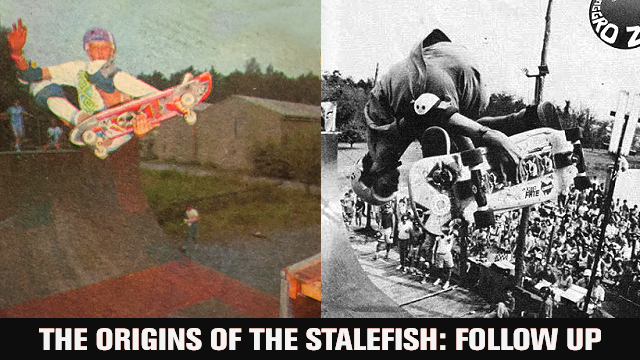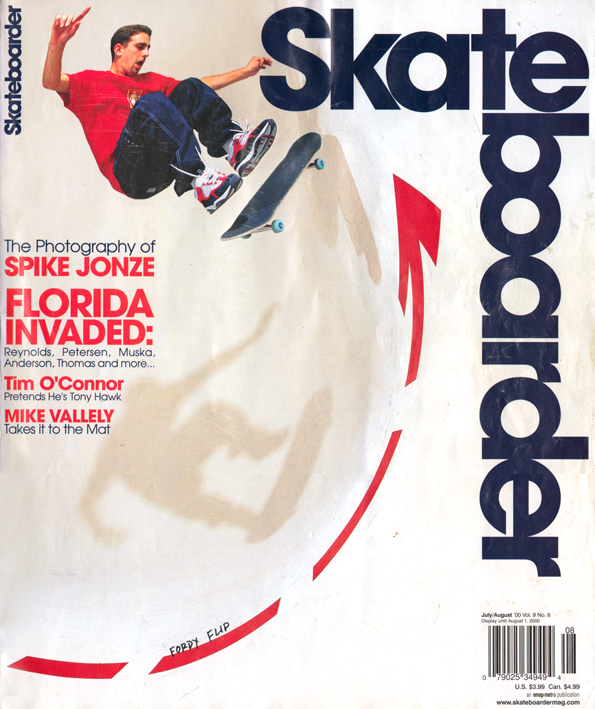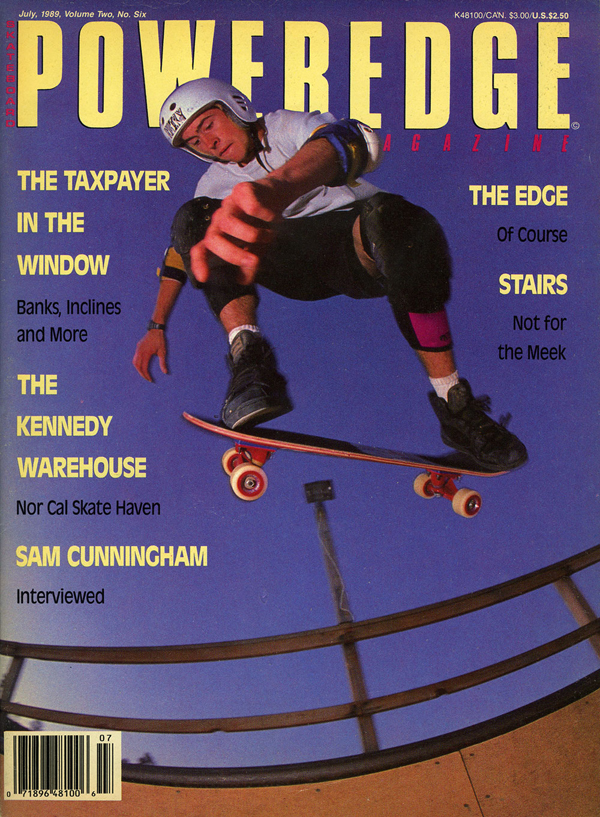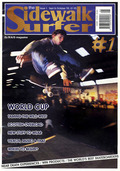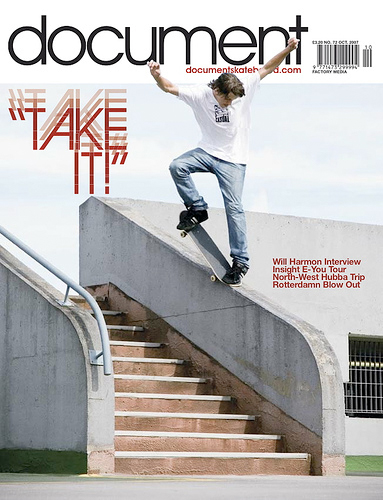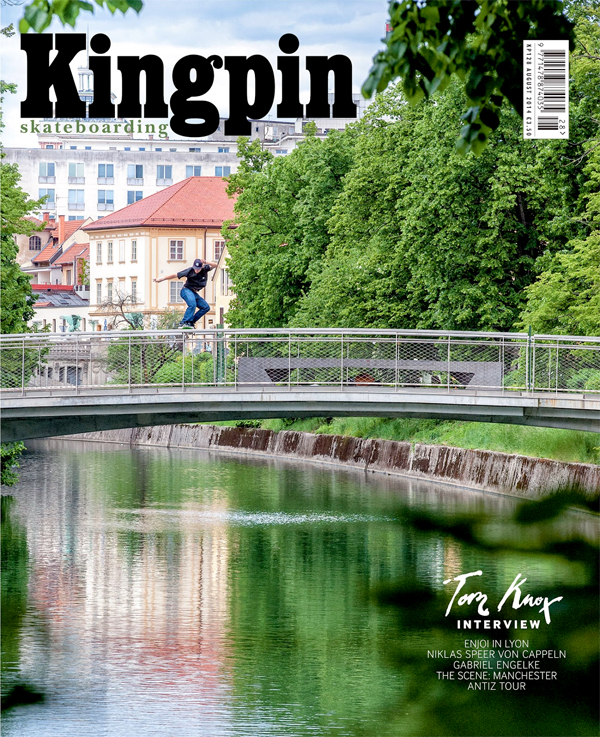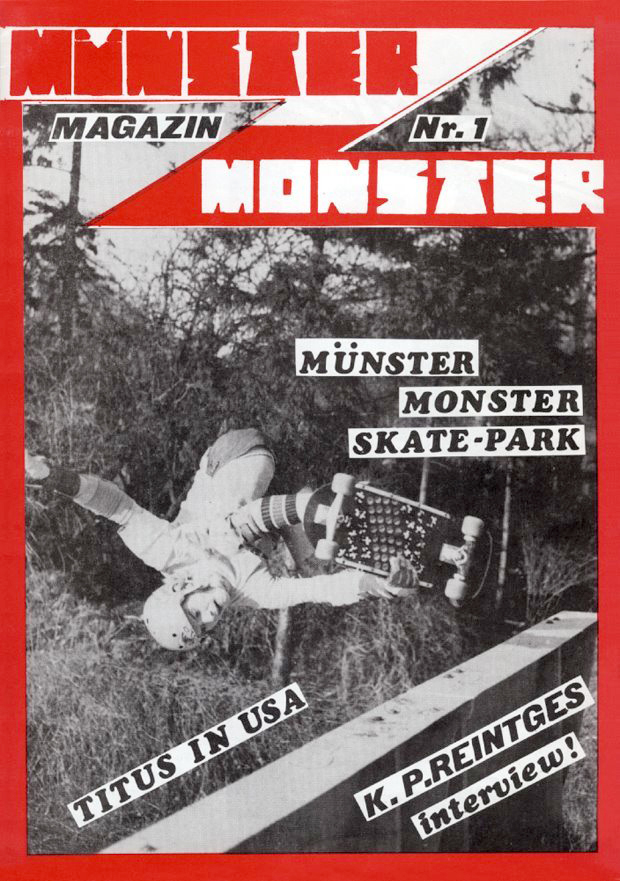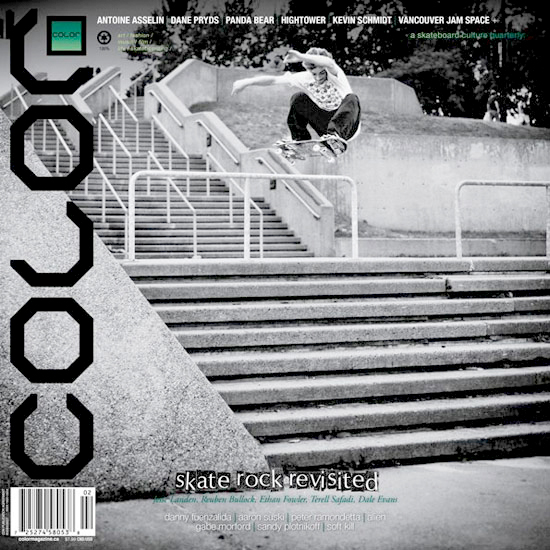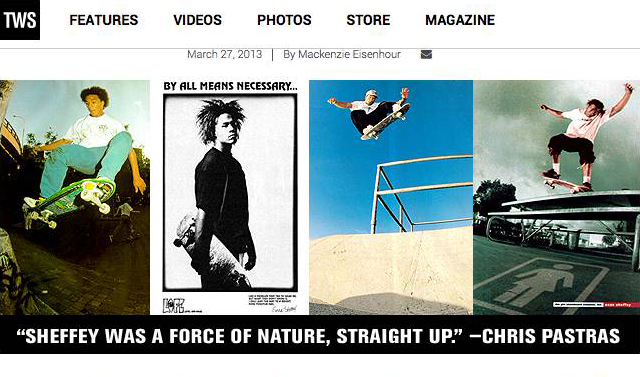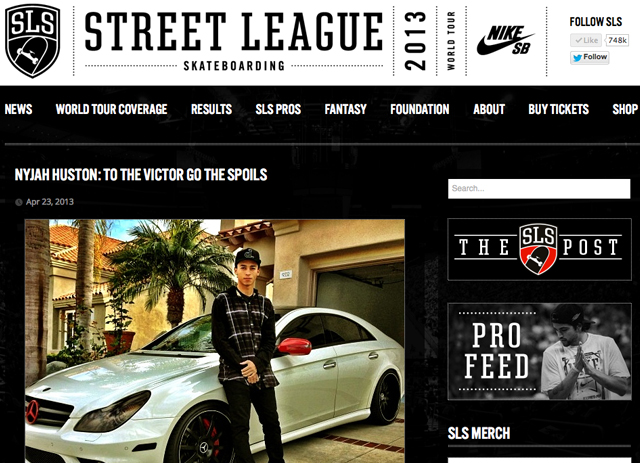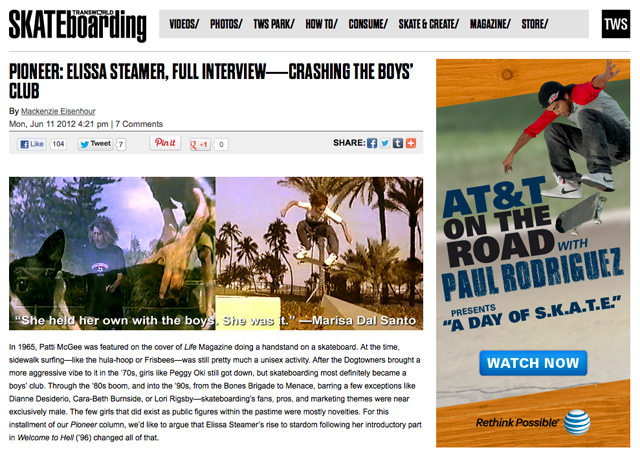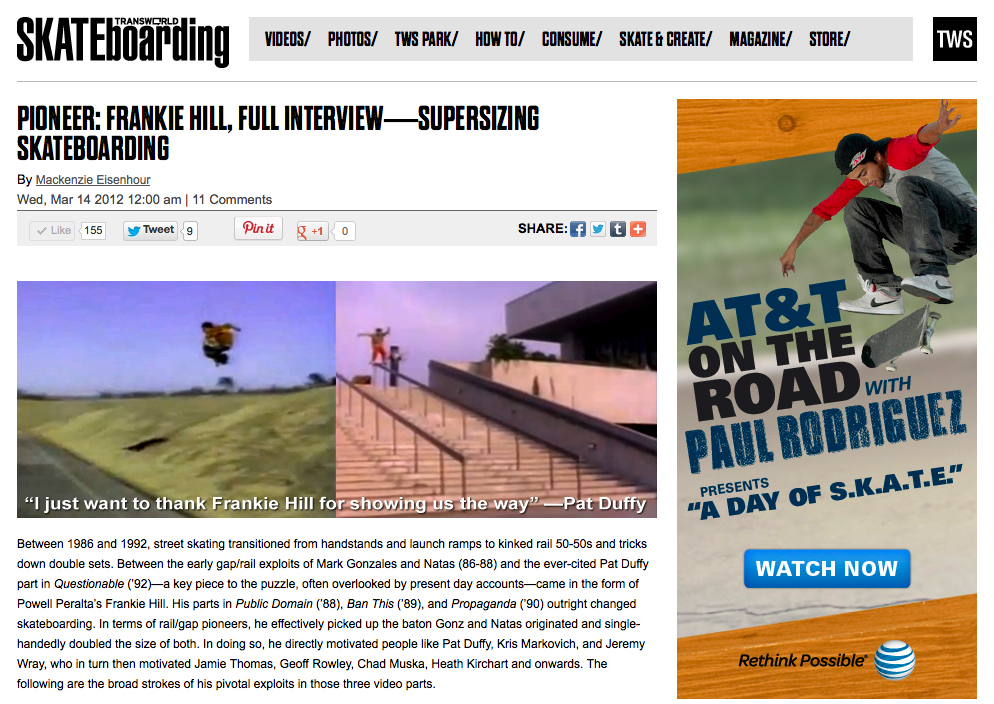Gonz and Hawk: The Origins of the Stalefish (TWS 2016)
 Friday, February 15, 2019 at 10:40AM
Friday, February 15, 2019 at 10:40AM 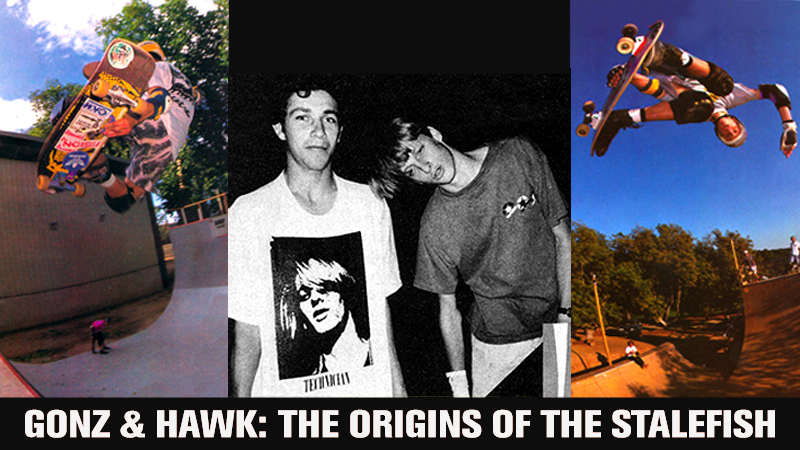
WARNING: LONG READ! TERMINAL SKATE NERDS ONLY.
All I can really do is tell this story from the beginning. Six months ago I had routinely interviewed Mark Suciu for his Pro Spotlight in the mag. Between explaining his road back from injury, French philosophy, and the ins-and-outs of college freshmandom, he had randomly mentioned that while on an adidas filming trip with the Gonz in London—Mark (Gonz not Suciu) had been telling them one night at dinner about his dismay over Tony Hawk’s refusal to acknowledge him as the first to do the stalefish. As any semi-competent skate journalist might do, I made a mental note to pursue the matter.
A few deadline weeks later, I reached out to Skin Phillips and the dudes at adidas to see if Mark (Gonz) might be interested in discussing it. I asked Skin (our former Editor-in-Chief and a pretty seasoned skate historian) what his general understanding was of the stalefish’s invention. At this point, the grab is obviously a pillar of skateboarding. Like me, the official story Skin had heard through the years was that Tony Hawk had done them first at the Swedish Eurocana Summer Camp in 1985 (the same summer he invented the 720) and the term “stale fish” had come from the stale herring served at the camp lunches. However when it came to the first photo of one, he was sure that the Grant Brittain photo of Gonz tweaking one at Bourges skate camp 1987 in France (TWS Dec. 1987) was the first stalefish photo he had seen.
Upon doing the basic searches online, that was pretty much the extent of the information available there too. Most credited Tony as first, while many also credited Mark with popularizing the trick and “injecting style” into it. Tony himself claimed on his Instagram that while he had done it in 1985, and had it named for him by a fellow camper at the Swedish camp—Gonz was also possibly doing the trick at the same time or before. Hmmm. Meanwhile, as far as photos, Grant Brittain’s Bourges photo of Mark was most definitely credited—even by Grant himself—as the first published photo of the Stalefish. Adding to the mystery, the Gonz photo had run in Tony Hawk’s own TWS column at the time called “Beyond”—a column dedicated to NBD moves and progression.
While we may never truly know exactly who on God’s green earth grabbed between their legs/ behind their back foot first—surely someone had done so at some point during the '60s/'70s/'80s—it seemed we should at least be able to ascertain who had officially done it first between Mark Gonzales and Tony Hawk—numbers 1 and 2 respectively on TWS’s “30 Most Influential Skateboarders of All Time” list in 2012. Furthermore, how could two entire years tick off the clock (a lifetime in skateboarding’s progression arc circa 1985-87) before anybody shot a photo of the trick? I set out to find out.
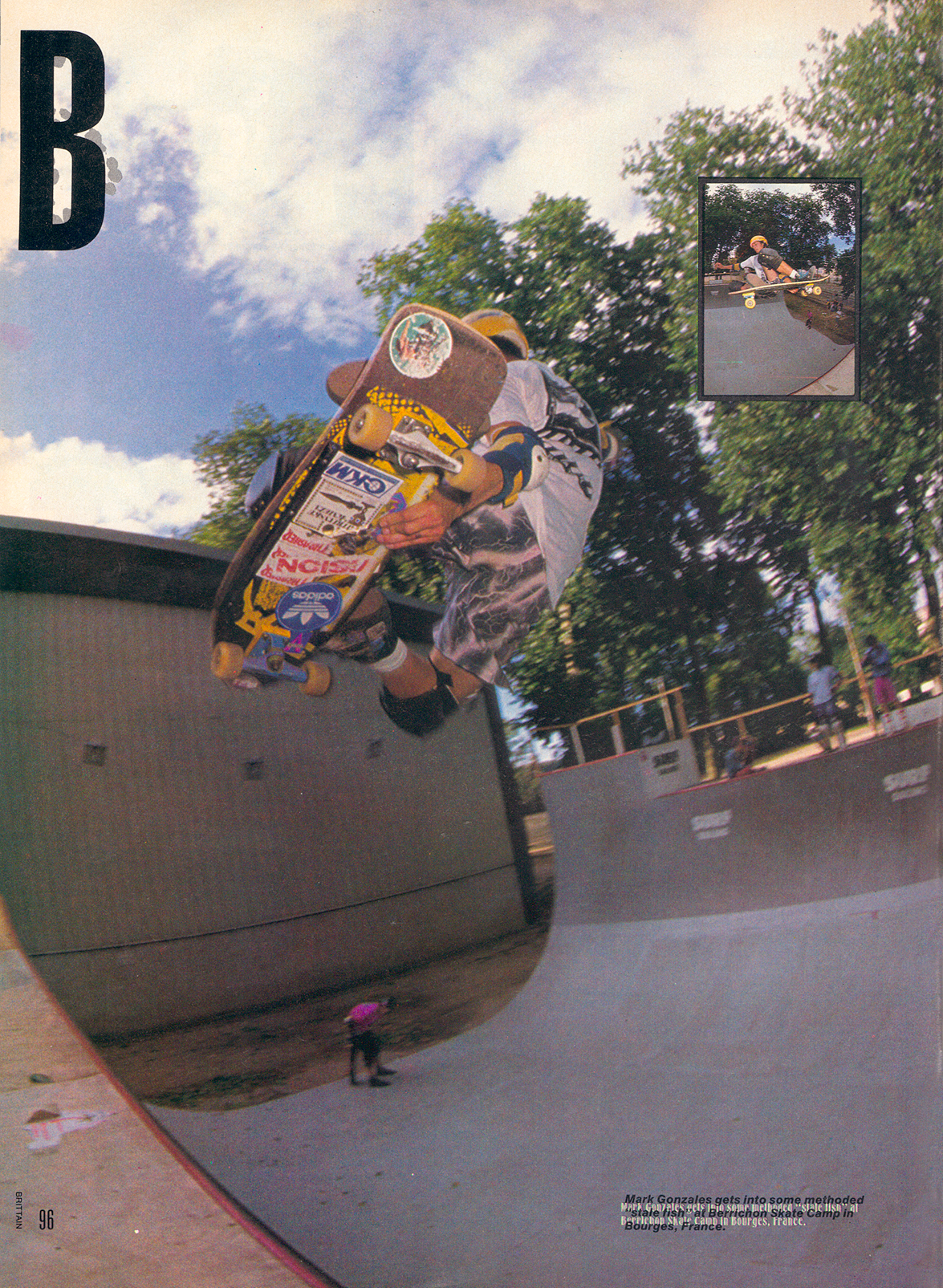
Exhibit A: Gonz's tweaked Stalefish (Brittain) from Bourges, France during the summer of 1987. Regardless of it being the first or the last—it will always be one of if not the best photos of the trick. TWS Dec. 87, Vol.5, No. 6.
GONZ
To my surprise Gonz got back to me almost immediately. Full disclosure, I’ve worked at skate mags for 16 years now and had yet to so much as speak to Mark. I had seen him skate only once in person at an ASR show in Long Beach during the early ‘00s. Then Skateboarder staffers, Jaime Owens and I looked on in disbelief as Mark casually feeble grinded a sliding unanchored flat bar that rotated a near 45 degrees under him mid-feeble before he popped off unfazed (Ask Jaime Owens to show you this footage). Suffice to say I am a huge fan. Gonz is it. I did not want to mess this one up.
I’d also like to add that regardless of the outcome of this article, and regardless of whether Animal Chin did the first Stalefish in 1932 while touring Manchukuo—the best Stalefish of all time for me will still forever be the tweaked method one Gonz does in his Video Days (’91) part on Hosoi’s ramp in Hollywood. I just wanted that stated for the record.
After some emails back and forth through Skin, then Mark’s wife Tia, Mark’s name finally came up on my cell phone late that morning. It may as well have said John Lennon or Jesus Christ. I could hear my own voice cracking as I answered and tried to act casual. Mark was polite and jovial, but immediately set out to make his case.
“For the Stalefish. It was at the Bourges camp in France. Joe Johnson was there. Kevin Staab was there. Gator was there. Chris Miller was there. J. Grant Brittain was there. And I had been talking with Lee Ralph and my skate buddies that I skate with about this (frontside ollie) photo I had seen of Jeff Phillips (Swank photo, TWS Photo Annual 1, 1986).”
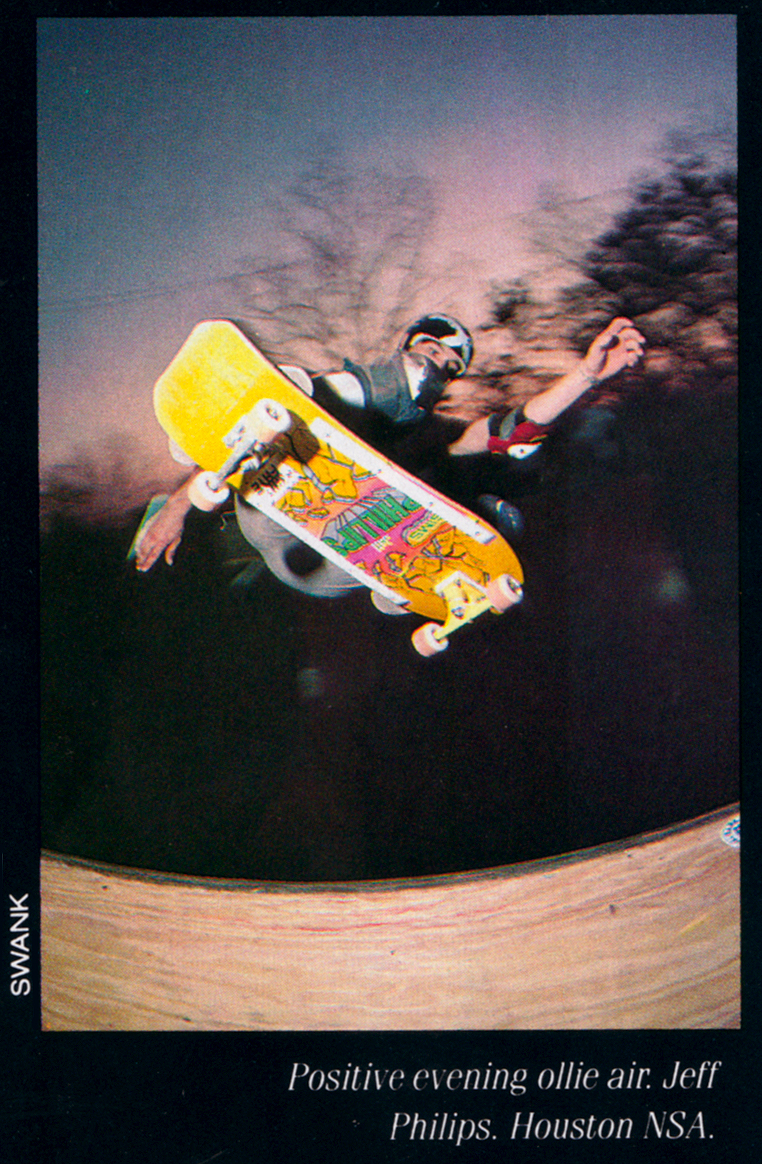
This was the Jeff Phillips ollie photo (Swank) that inspired Mark to grab Stalefish. TWS Photo Annual 1986.
Mark explained that he had gotten the idea to grab stalefish from looking at the photo of Jeff Phillips’ frontside ollie in TWS’ first Photo Annual. “His hand was very low on the board. It was all the way down. And I thought, ‘Wow, you could just… if he just turned his hand upward—he could grab that.’ So then on that tour, or at that skate camp (Bourges 87)—I did it.”
Mark also had a vivid memory of Tony Hawk being there at that time and having trouble grabbing it. “Tony was having a hard time getting his thumb on the top part of it. So he just did a straight up “palm” air. Like where you grab with all palm.” As far as the actual name “Stalefish,” Mark wasn’t totally sure but thought it had might have come from a girl. “Like “She’s stale, she’s a ‘stale fish’.”
I could tell that Mark was absolutely telling the truth as far as he understood it. To him it was just a trick he had imagined was possible and then he had gone and done. “It was just something that I saw in that Phillips photo and thought you could do. I never thought of it as anything more.”
But of course, immediately I realized the Jeff Phillips photo that inspired Mark (’86) was still published a full year after Tony had supposedly done the Stalefish and named it in Sweden (summer ’85). I mentioned this to Mark and he said anything was possible. Still, he was pretty sure that Tony had been trying them with him at Bourges. I asked if Tony might have done a sketchy one first in Sweden, then perhaps tried them again two years later with Mark at Bourges. Mark was still pretty convinced that wasn’t possible.
“No. I don’t think so because I remember specifically speaking with him back and forth about learning it. And I said, ‘Well, if you can’t grab it, just palm the son of a bitch.’ Like how (Mike) Vallely does his backside airs. Vallely would palm the whole thing. And that was exactly what Tony would end up going away with from the Bourges camp. That and the padless 540.”
I asked about when the first Stalefish grabs on street came about. Mark said those came later: “On street, I would do these 180 ones that came out for a Vision Street Wear ad. It said “New Art” (Ad for Mark’s new board graphic, TWS, 1988) and I’m doing a frontside 180 into a Stalefish. It doesn’t really make sense to do a Stalefish on street and continue forwards because your momentum pulls you 180. Unless you’re going over a hip or something it didn’t make sense. That was after Bourges though, when I came back”
Gonz's "New Art" Vision ad with early front 180 Stales on street. TWS 1988.
I told Mark that I would talk to Tony, get his side of it and then get back to him. He put his daughter Gemma on the phone to say hello. Mark: “Say ‘peace’. (Gemma says “Mish”.) That’s the way she says peace.” Mark told me he would be happy to speak to Tony about it and welcomed any new information. I hung up the phone and felt more confused than ever.
HAWK
Next up I would call Tony. I felt bad contacting him once again over a trick dispute of sorts, even if this one was friendly. The last time I hit up Tony, also the first time I had talked to him, I had asked him for his side of the Tas Pappas 900 allegations from the “documentary” All This Mayhem. I suppose when you sit on the highest perch a la Birdman, it is par for the course to face somewhat constant challenges. Either way, at one point during our conversation Tony did make light of it, “Just another trick that I stole right (laughs.)” At least Tony had a good sense of humor going in.
I went through it from the beginning with Tony and explained that I had talked to Mark. Off the bat, he was open to giving Mark credit. As far as Sweden in ’85, Hawk explained, "I don’t feel like I necessarily invented it then. But that’s just where it got named. To be honest, I don’t remember seeing Gonz do it before I did it. But it’s probably around the same time frame."
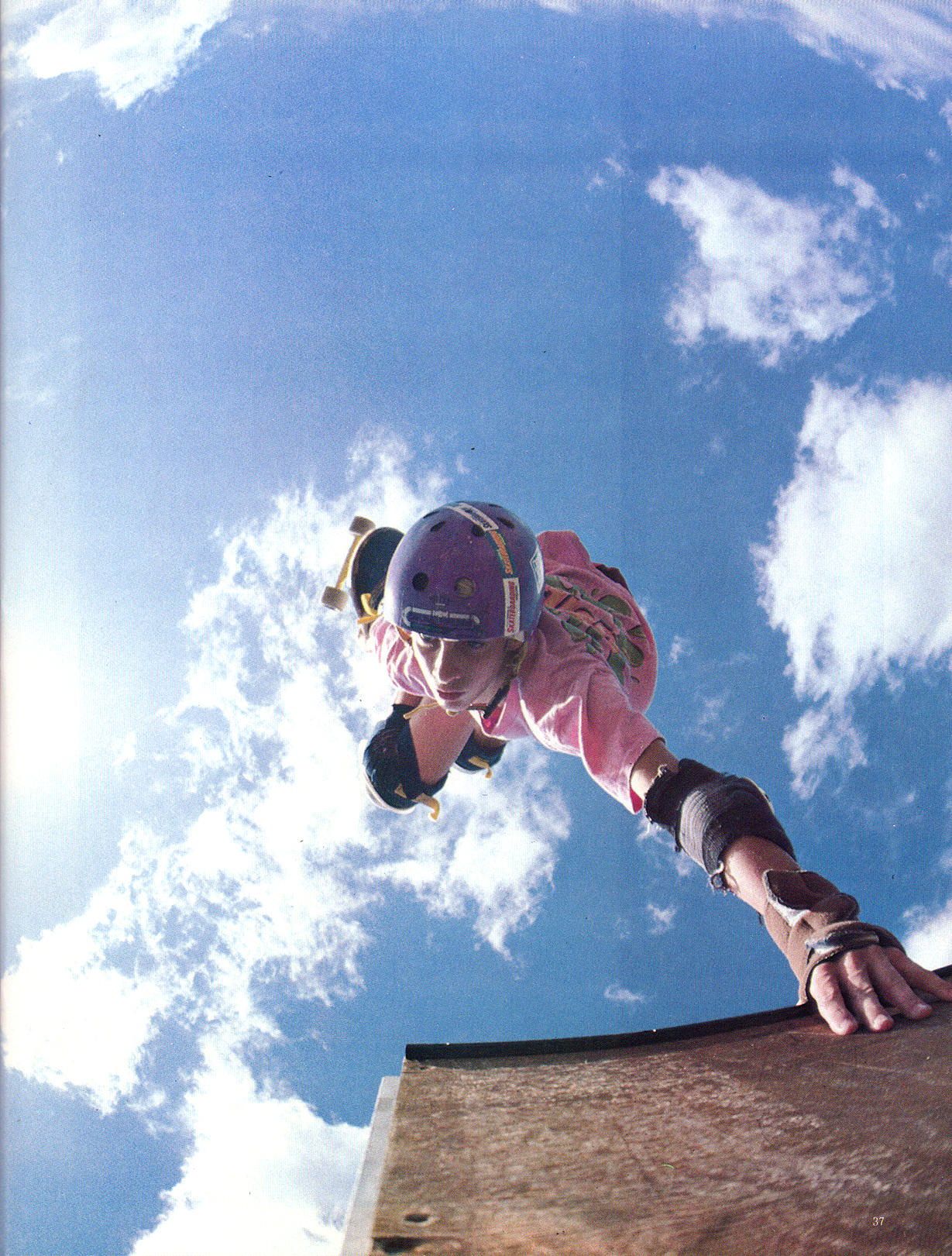
Lance Mountain's iconic photo of Tony lifting an invert on the extension at the camp. Sweden, 1985. TWS Photo Annual 1, 1986.
As far as the name, Tony recounted the official version I had heard before, “I was in Sweden in ’85 and I was doing that grab. I didn’t have a name for it. And this British dude that was there, I’ll never forget it. He grabbed my diary that I was keeping during that summer camp. It was super cryptic. I was just keeping notes of things that happened throughout the day. And so he took it and he read it—kind of without my permission. And he was reading through it and he’s like (in thick British accent) ‘Stale fish? What is a stale fish?’ And ‘stale fish' was what I was describing our lunch as every day.”
Tony continued, “They actually gave us a whole herring fish in a tin. A whole herring with bones and rice. I was only eating like McDonald’s and pizza at the time so I just thought it was gross. I had written ‘Stale fish with many bones.’ And this guy. I want to say his name was Mark Edwards (Ed. note: According to Martin Willners there was a Mark Evans at the camp, but he claims it wasn't him. It may have been Mark or Barry Abrook. I am waiting to hear back from more sources.)—he took a bunch of photos back then. He was like, ‘Stale fish? What is that? Is that that trick you do where you reach behind with your back hand?’ And I was like, ‘Sure.’ Because I didn’t have a name for it. And that was basically it. For me, the name was sealed. But it’s very likely that Gonz never saw me do it then (in ’85) and then he was doing it. But if you’re looking for an actual time-frame, that was definitely in ’85 at the summer camp. Because that was also the same year that I learned 720s.”
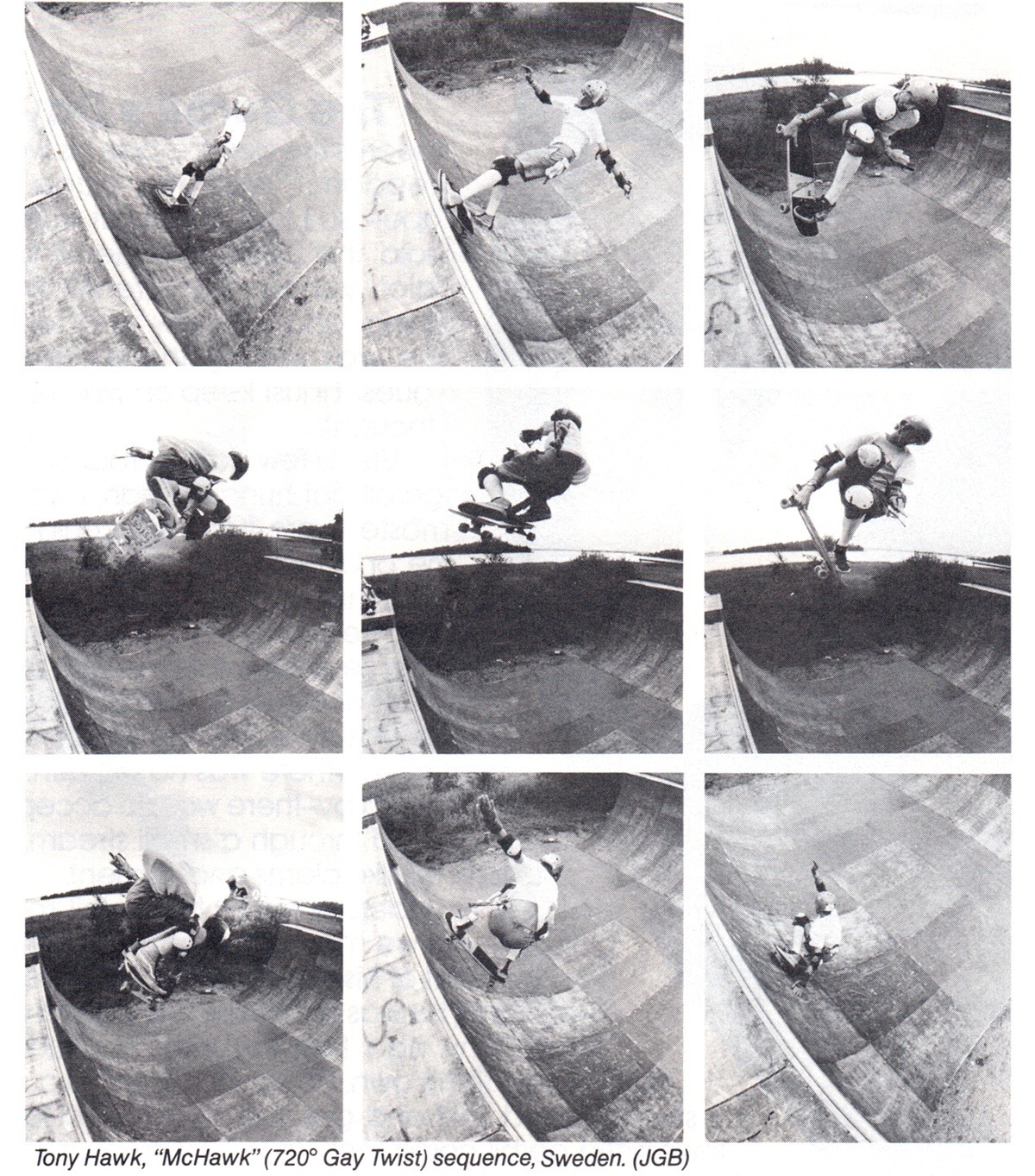 One of if not the very first 720s ever landed on the ramp at Eurocana (Brittain). TWS Feb. 1986. Vol. 3, No. 1.
One of if not the very first 720s ever landed on the ramp at Eurocana (Brittain). TWS Feb. 1986. Vol. 3, No. 1.
I asked if Tony had held on to the diary. He hadn’t. But he said Lance Mountain could corroborate. Lance was in Sweden that year as was Grant Brittain. I agreed with Tony to talk to them both after I got off the phone with him. With Tony’s account of the Swedish summer somewhat squared; I relayed the Bourges “palming it” story next. I asked him if he had any recollection of talking with Mark (Gonz) about the trick there. “I honestly don’t. If anything though, it was probably because I was trying to do it like him. I probably wanted to tweak it like him.”
I asked if he remembered putting the photo of Mark’s tweaked version in his “Beyond” column. “ I kind of remember it. But I’m sure that the reason I put it in there was because I thought it was so awesome that he could take it to a different level like that.” He also confirmed that it was the same summer as the padless Mctwist. So at least that part added up.
The more we talked, the more I became convinced that Mark may simply not have known that Tony had already done the grab in ‘85, had learned it for himself at some point after ’86 from seeing the Phillips photo, and then due to this session at Bourges ‘87—where Tony was trying to get them tweaked like Gonz—Mark had mistaken that for Tony never having done it before. Still, I needed to prove once and for all that Tony had in fact done it in Sweden. I finished up the conversation with Tony, not before he added some fun memories of being with Mark in Europe in the ‘80s.
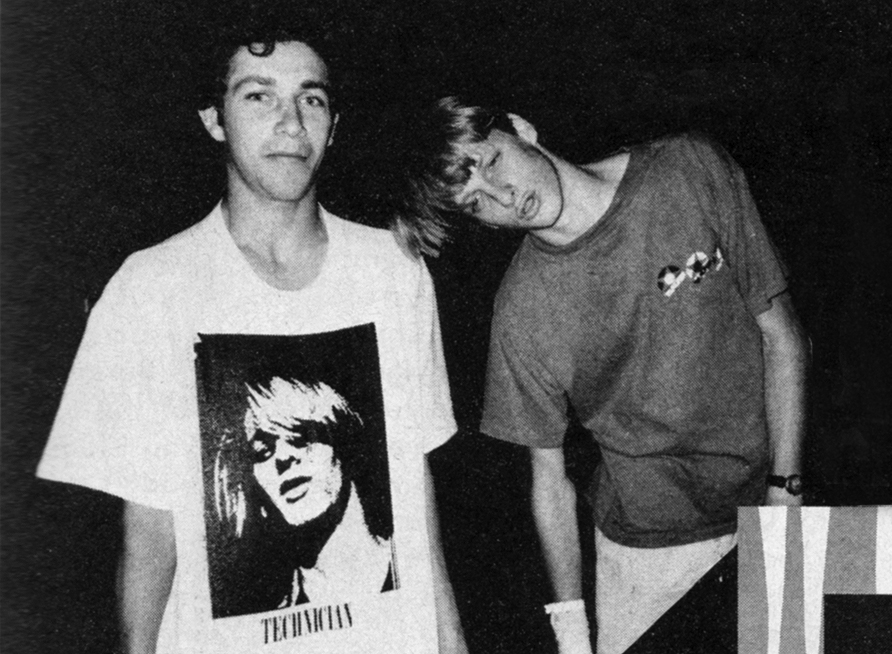 Mark and Tony the Technician on the 80s contest circuit (Brittain). TWS Dec. 1988, Vol.6, No.6.
Mark and Tony the Technician on the 80s contest circuit (Brittain). TWS Dec. 1988, Vol.6, No.6.
“I do remember my time with Mark vividly in Paris too. We were going around Paris. We were so young and basically on our own. I remember he took me out to this super fancy Japanese place in Paris and put it on Vision’s dime. He had a credit card that went straight to Vision. I was like, ‘That’s crazy. There’s no way Powell would give us that.’ Mark was just always so fascinating. He was such a character. He was so creative. But he was also kind of aloof. He would just be gone at times. Like, ‘Hey Tony, I’m gonna go to Italy.’ And then he was gone. But he would leave his bags and everything and just be gone to Italy for a week.”
GRANT BRITTAIN
I hung up with Tony and called Grant Brittain. Having been both at the Swedish camp in ’85, and the Bourges camp in ’87, and having shot the purported “first Stalefish” photo of Mark he seemed like the best person to unlock the whole mystery. Let me also take this moment to thank Grant for all of his incredible photography through the decades. Without the handful of key photographers like Grant, Bryce Kanights, Stecyk, Sturt, Cassimus and onwards, skateboarding’s history would be even more clouded and cryptic than it already is. So thanks to those guys for documenting it.
 Grant's sequence of Tony's padless 540 at Bourges, France in 1987. TWS Feb. 1988, Vol. 6, No.1.
Grant's sequence of Tony's padless 540 at Bourges, France in 1987. TWS Feb. 1988, Vol. 6, No.1.
Grant absolutely remembered being at both places. Grant confirmed that the Gonz “Beyond” photo was from summer of ’87. However when it came to Sweden ’85, he said he didn’t remember Tony doing it. He couldn’t confirm having witnessed the grab firsthand. He shot the sequence of Tony’s first 720 and even had a photo of himself eating the actual “Stalefish” herrings said to have spawned the name. But he didn’t have any memory of Tony doing the grab or have any photos of one. “I was in Sweden. I don’t remember him doing it though. He was there all summer and I think I was only there for maybe a week.” I was so close, but still no Stalefish. How was this possible? I pinned my hopes on Lance next. Tony had already texted over Lance’s number to get the ball rolling.
LANCE MOUNTAIN
After a few texts and voicemails, Lance called me back the following morning. “What’s the point? What are you doing this for?” Those were the first questions Lance asked, almost before I could even get my introduction off. I could see where he was going. By now I was just praying that the whole thing was a misunderstanding. The further into the story I got, the scarier the prospect became of making one of the two Hall of Fame legends look bad. I tried to convince Lance that I wasn’t trying to stir up drama. This wasn’t TMZ style beef seeking or trolling for click bait. I simply genuinely wanted to know who did the Stalefish first. At least between Tony and Gonz.
As far as Lance’s memories of Sweden, he said he, like Grant, didn’t actually see Tony do it firsthand at the camp that summer. He remembered the story of Tony’s diary and could confirm that it was real but couldn’t claim to have witnessed the grab in question. He said if I really wanted to do this thing, I would have to track down the people that were at the camp. He texted me a list of contacts.
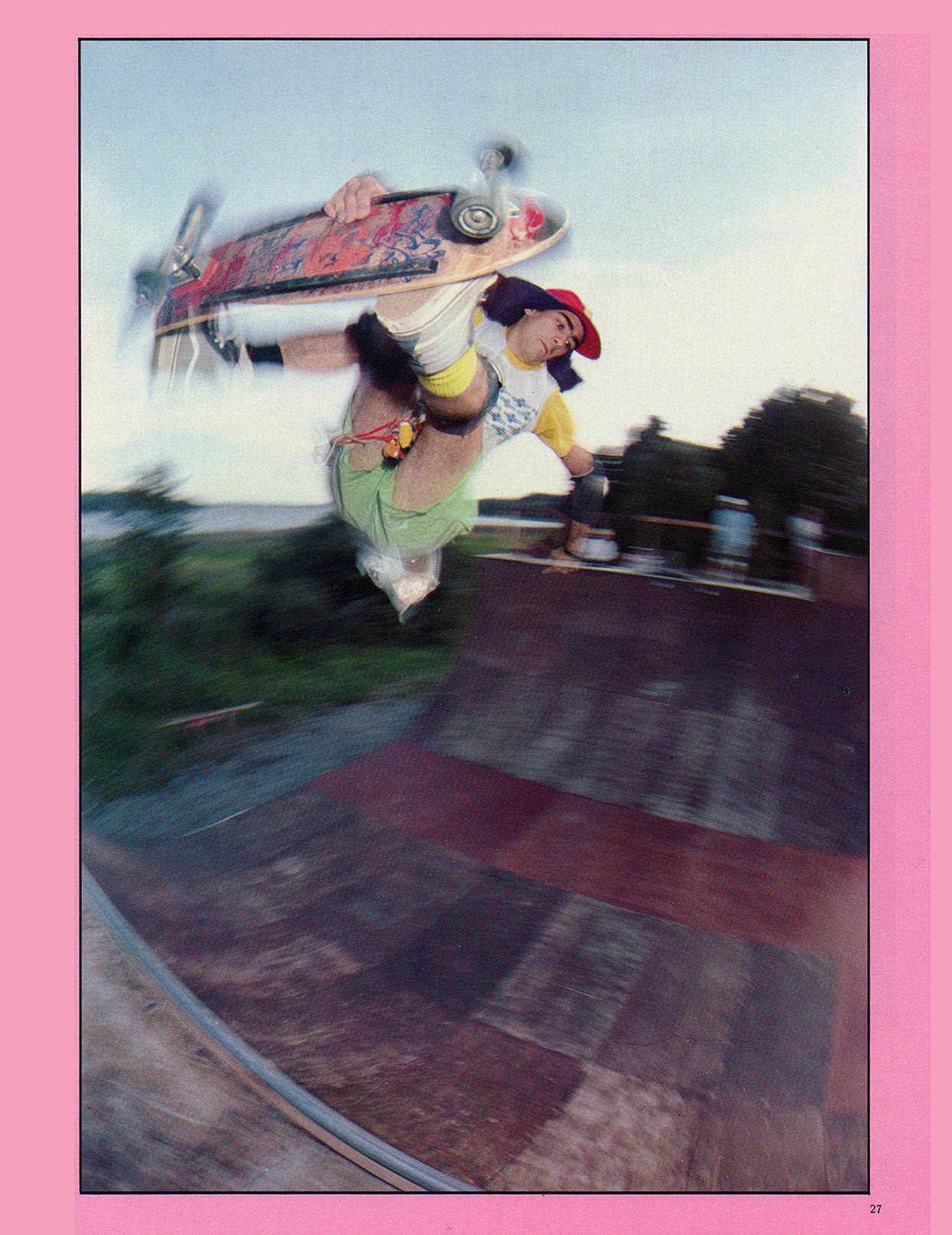 Lance lofting frontside with some flair. Eurocana, Sweden, 1985 (Brittain). TWS Photo Annual 1, 1986.
Lance lofting frontside with some flair. Eurocana, Sweden, 1985 (Brittain). TWS Photo Annual 1, 1986.
Lance also had memories of Gonz trying countless strange tricks and grabs through those years and couldn’t discount the possibility that Mark might have done it around the same time or before ‘85—even if Mark didn’t remember doing it (before seeing the Jeff Phillips photo [’86]). One of the last things he said was that he was all but sure he had seen Mark try them backside on his ramp at his house (The legendary Mountain Manor) only a few weeks before leaving to Sweden in ’85. Another massive twist in the plot.
I had pinned all my hopes on Lance being the peacemaker and eyewitness of record. Instead, my case seemed weaker than ever. Resigning myself to somewhat of a last ditch effort, I would now be tracking down Martin Willners, the Eurocana Camp Leader and Photographer from ’83-’85. God knows what Martin had been up to over the last 30 years, but I sure hoped it included maintaining spotless records of the Scandinavian youth camp he managed in the early ‘80s. If neither Grant nor Lance had seen Tony grab Stalefish, and Gonz was convinced he couldn’t do it properly two years later it was looking increasingly like I should just leave the whole thing alone.
MARTIN WILLNERS
Martin responded to my email inquiries a day later. He was on a business trip through Norway but would look through his photo files and see if he could find some proof when he got home to Sweden. Martin works for/runs a sporting goods trade magazine called Sportfack in Scandinavia. If Martin came back negative, my next bet would be Claus Grabke, then if not Claus, the Instagram handle @skateputtis, and if not that—a Spanish distributor by the name of Francisco. I pinned my hopes on Martin.
Four days after our first email chat a new message from Mr. Willners popped up in my inbox. My eye immediately locked on the attachment icon. Never in my life has that tiny paperclip graphic looked so good. I clicked on the attachment and boom there it was—almost too perfect to be true. A young Tony Hawk, clear as day, in sharp black and white—crouched, high above the Eurocana ramp, and clearly not only grabbing—but unabashedly tweaking a Stalefish—backside. Holy shit! Eureka and WTF all at once. I not only had a witness, I had hard photographic evidence.
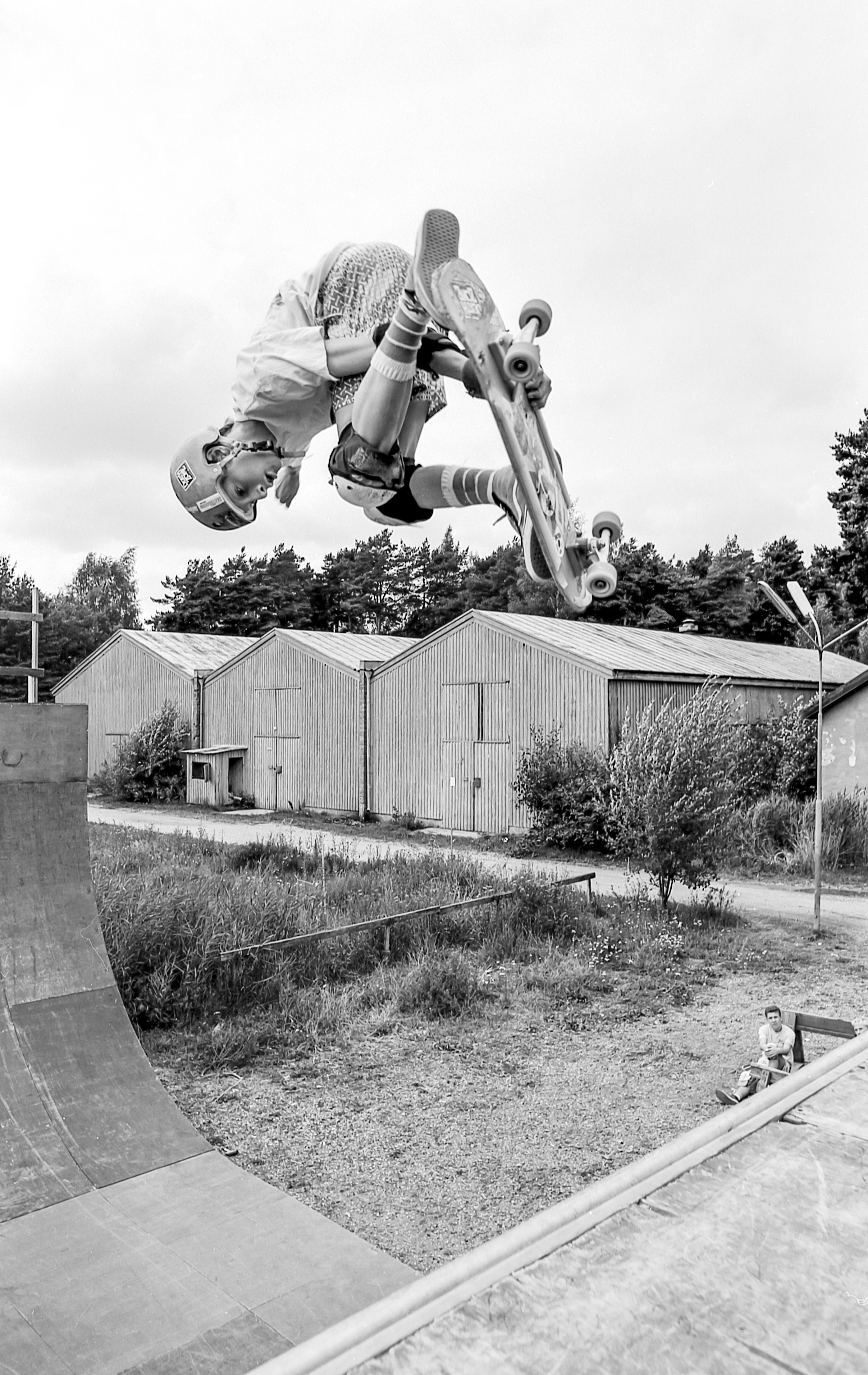
Eureka! Tony Hawk tweaking a backside Stalefish in the first photo of the trick. Photo: Martin Willners. Eurocana Camp, Sweden, 1985.
I wrote Martin back immediately thanking him emphatically and expressing shock at the fact that it was backside. Yet another curveball in a story already full of twists. I asked Martin his thoughts on witnessing the trick. Had he realized it had never been done? Willners explained, “The truth is that it was not a big deal. Tony did so many strange tricks that I guess most of us didn’t realize it was a totally new trick.” The photo, essentially the first Stalefish photo ever, had never even been published.
Had he seen Tony try any frontside? “Probably not. I have no memory of it and no photos to prove it.” Did he witness the “naming of the trick” via Tony’s journal? Martin replied, “I do remember the fish lunch since I was the one picking it up from the catering. I knew it wouldn’t be popular among the skaters. Everybody just hated it but it was only years later I heard that Tony named the Stalefish after that lunch.” Finally, I asked Martin if he saw anyone else try the grab that summer or around that time. His response, “I don’t think so. I have no photos in my archives. My first photo of a Stale besides Tony’s backside Stales in 1985 is from 1987 and then it is frontside Stales.”
LANCE 2
The photo from Martin finally proved beyond a shadow of a doubt that Tony had grabbed Stale in ’85. However, since it was backside, I began to believe that perhaps this was the key to the whole mystery. Maybe Tony had only done them backside before Mark did it frontside. That would explain the confusion at Bourges.
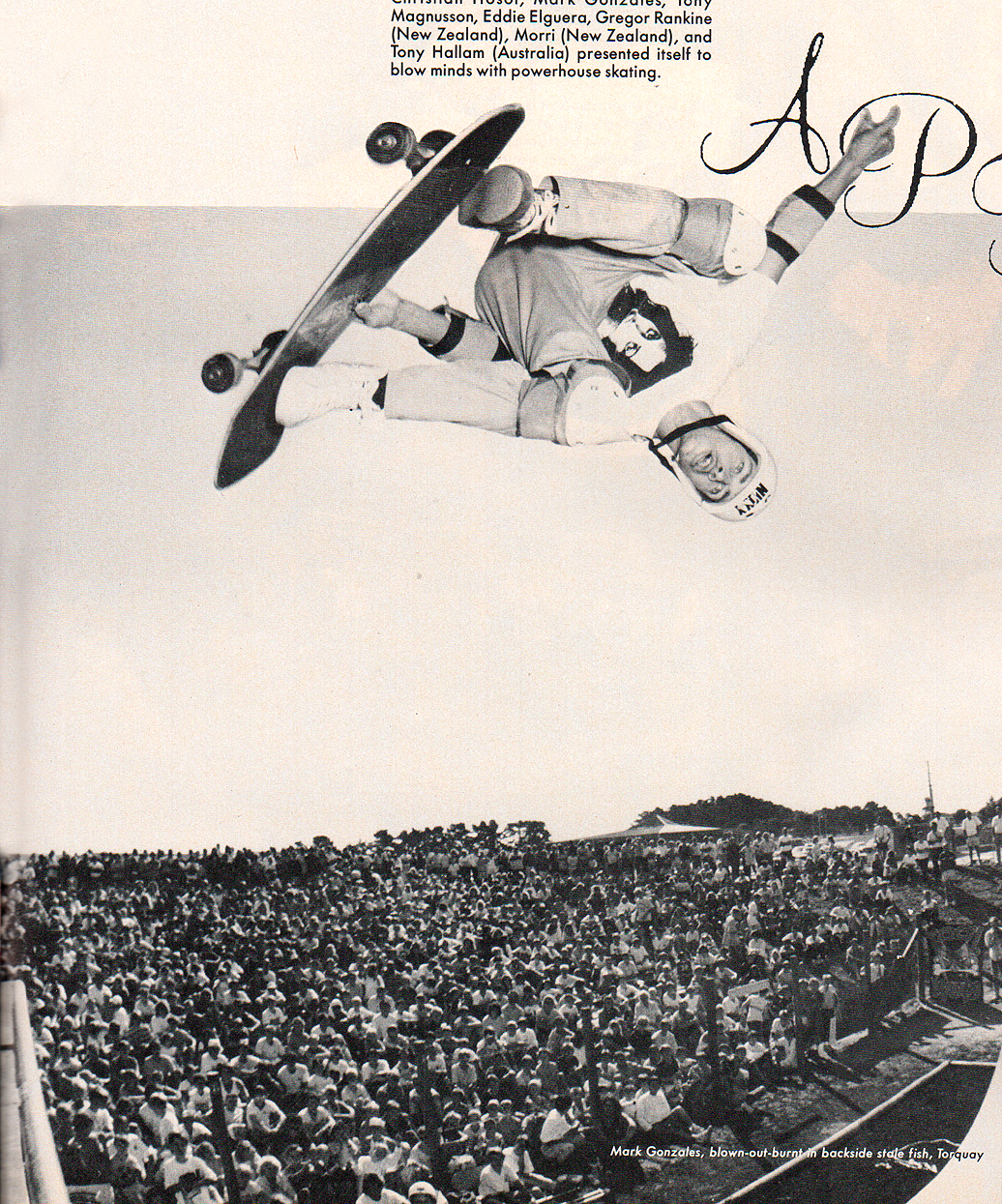 Gonz launching a backside Stalefish of his own in Australia. Photo: Walsh. TWS Oct. 1988, Vol. 6, No. 5.
Gonz launching a backside Stalefish of his own in Australia. Photo: Walsh. TWS Oct. 1988, Vol. 6, No. 5.
I texted the photo to Lance and thanked him for connecting me with Martin. He was as surprised as I was. “Wow. That’s his board before it fell apart and he rode the Lester.” Lance had asked what graphic Tony was riding to confirm the photo was from summer of ’85. Apparently he had ridden a Lester Sims board after his own board fell apart. So actually, the Stalefish had happened early on in his time at camp. I ran my backside/frontside theory past Lance and he said he doubted it. He said it was almost certain that Tony had still grabbed stale frontside first. And just to keep it interesting, he reiterated again that he felt like he had seen Gonz try them backside on his ramp right before.
HAWK 2
After Lance, I texted Martin’s photo over to Tony. He too reacted with equal part stoke, equal part surprise. “Backside?!?! So weird!” We agreed to get on the phone later in the day to discuss. Immediately, I brought up the new twist. Tony responded, “That’s so weird (it being backside). You know what I realized about that was that I was doing it without thinking that it was anything special. I guess that’s what it was. Even if Gonz did it at the same time—even though his timing seems off from the way that he remembers it—it just didn’t seem like this revolutionary grab or something that would become like a pillar in skateboarding. It just seemed like this weird behind the back thing.”
I asked Tony if it was possible he only did them backside in Sweden. Like Lance, he seemed somewhat sure it wasn’t the case. “No. I don’t think so. But again. Anything is possible. But it’s way easier frontside. So it just seems to me that I would have chosen that way first. Anyone would have. It’s just way more natural to turn it frontside. For sure, that’s how it came first. It just so happens that the photo is backside.”
We discussed how the 720 make—the most revolutionary thing done on a skateboard since McGill invented the 540 Mctwist in Sweden the year prior—had also clearly overshadowed something like a behind the back grab innovation. He elaborated on the Swedish vert ramp in particular: “The whole basis of the Swedish camp was that that ramp was bigger than anything built at that point. So we were able to go way higher there than ever. So that was the most exciting thing. It didn’t matter how you grabbed it.”
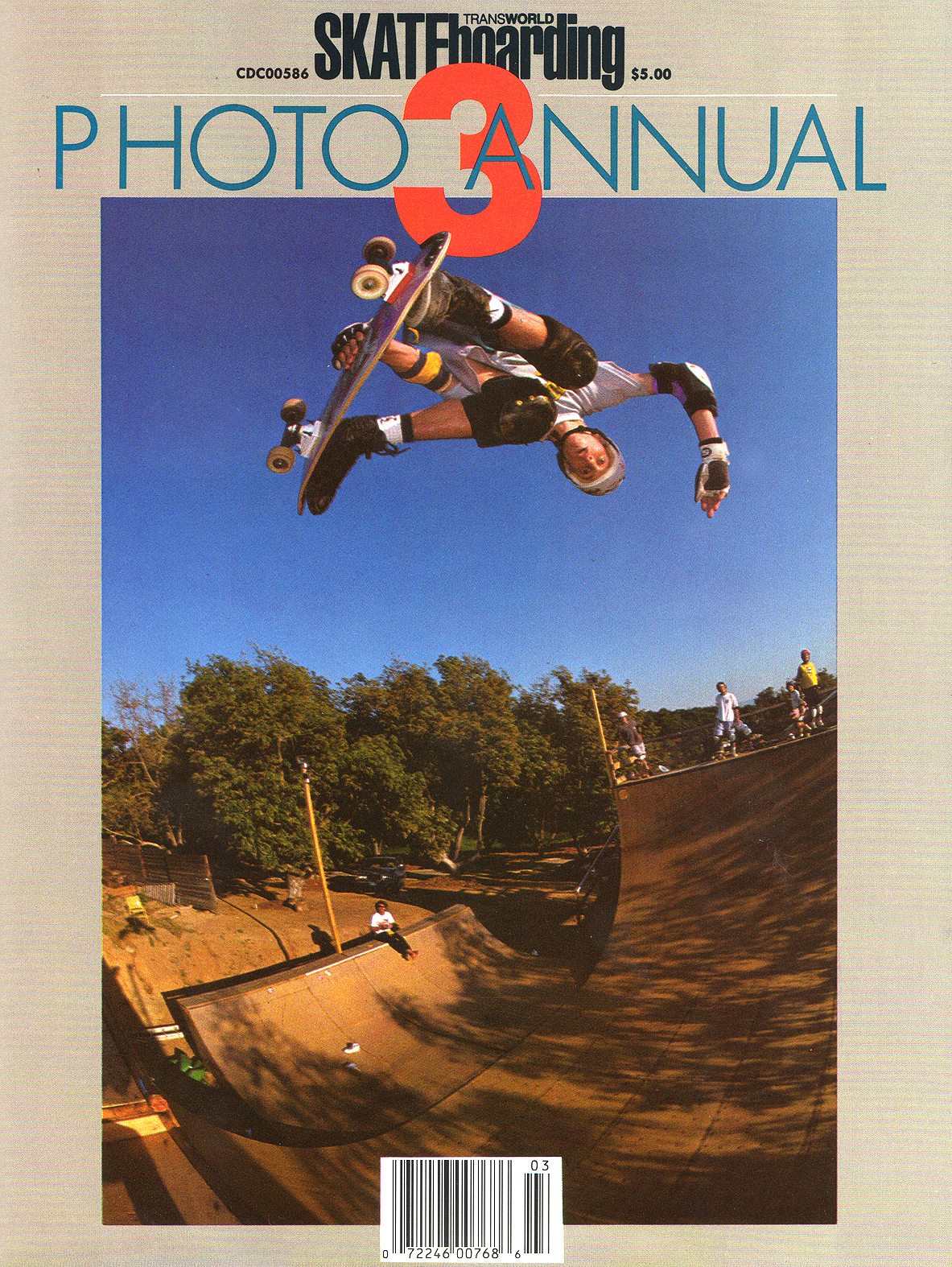
Hawk's back Stale from the cover of the TWS Photo Annual 3, 1988 (Photo: Brittain). Fallbrook, CA.
For the record, I asked Tony again if he ever saw Mark do it before they went to Sweden. “No. I don’t remember seeing him do it before. I remember him doing it through the years. But it was kind of like Martin said. At that point the grab of the air was almost incidental. All that mattered was how high you could go and how much you could tweak it. So getting a new grab, the actual way that you grabbed it didn’t really matter that much yet.”
I relayed Lance’s story of possibly seeing Mark try them backside at his ramp prior to leaving to Sweden. Tony said he remembered skating Lance’s with Mark, but did not have any memory of Mark trying Stalefish grabs then. But he still added, “It seems very likely that he would have figured it out at the same time if not before me. Just because he was in to all the strange grabs and strange ways of tweaking tricks. He just had this unique perspective. It’s very likely he would have figured it out before anyone. It’s such a bummer because I don’t want to disprove Mark. If he did it before me. Even if he did it before Sweden. That’s awesome. But those were my facts. That’s all that I know about it. And I’m more than happy to give credit to Mark for the trick. Even if his timeline doesn’t really match up.”
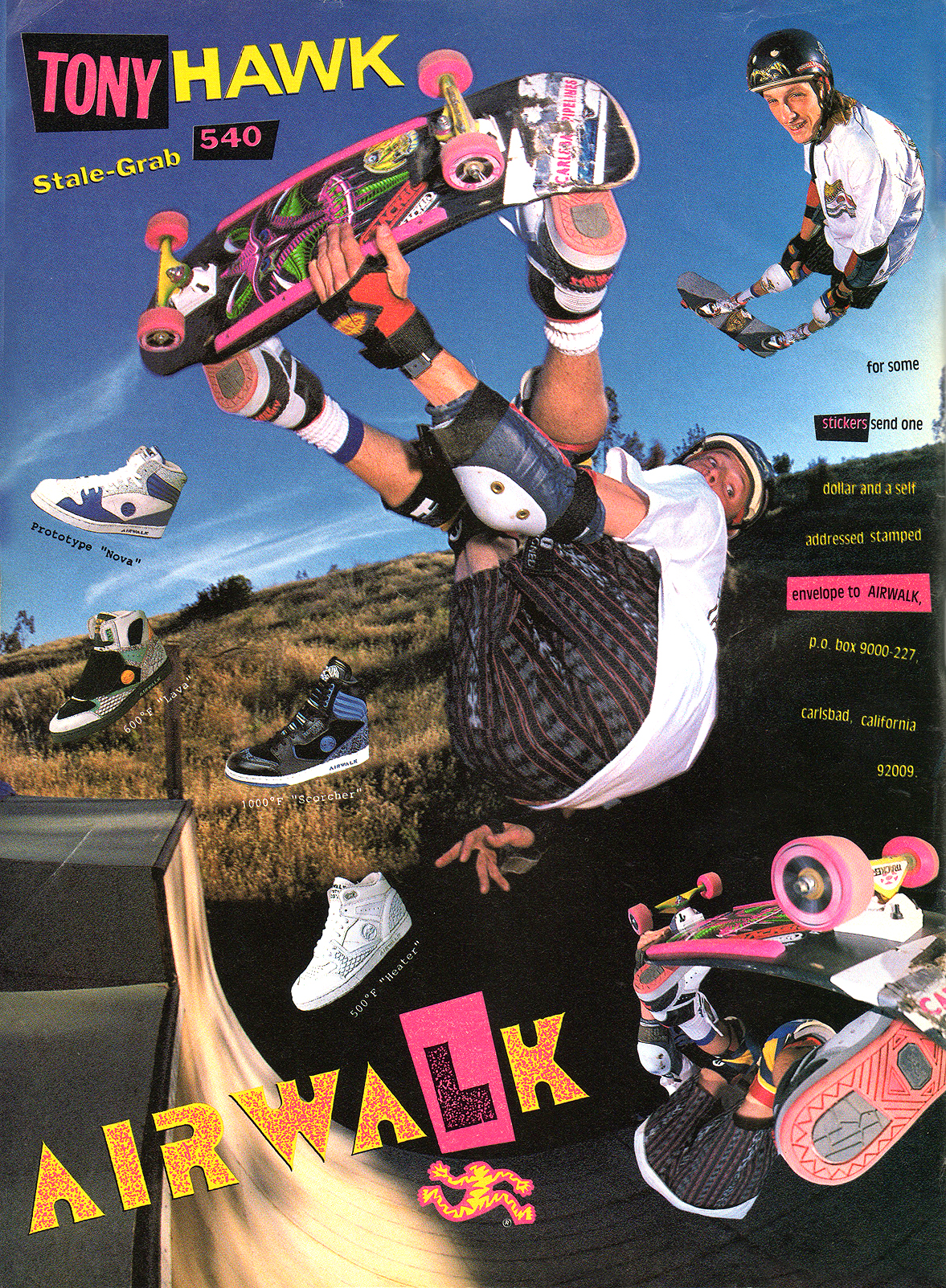
By '89, Hawk stayed true to his "Technician" label and unveiled the Stalefish 540. Airwalk ad, TWS Oct. 1989.
GONZ 2
It had now been two months since I had originally hit up Mark. By now, the dudes at the office had a running joke that I was sitting in a closet full of torn out magazine pages taped to the wall, obsessing over a thirty year old herring lunch. They were not too far off. The moment of truth had arrived. Bracing for whatever was to come I attached Martin’s black and white photo of Tony’s never seen backside Stale to an email and fired it off to Gonz.
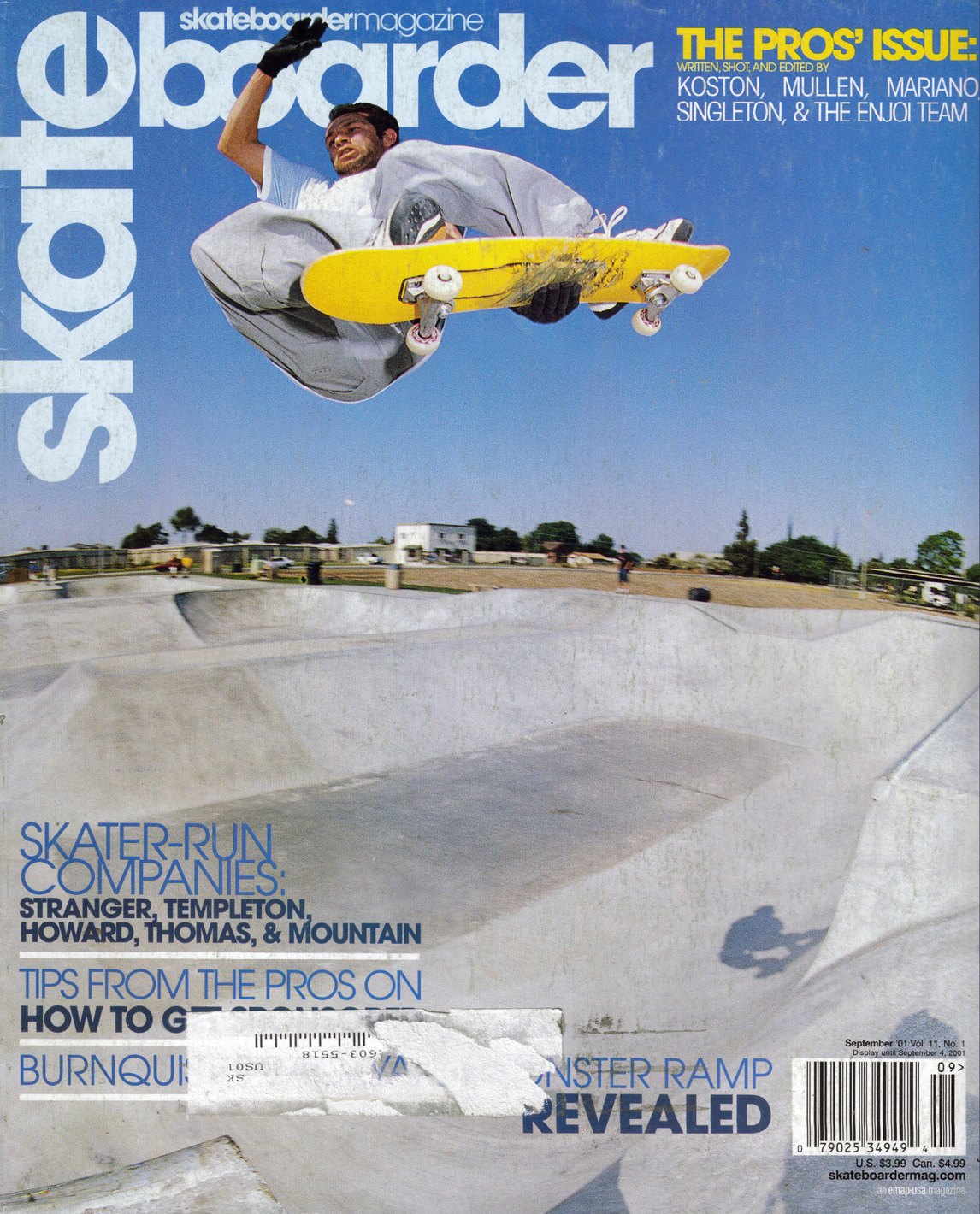 Gonz's channel Stale from his Sept. 2001 Skateboarder cover. Photo: Morford. Vol. 11, No. 1.
Gonz's channel Stale from his Sept. 2001 Skateboarder cover. Photo: Morford. Vol. 11, No. 1.
I went skating just to keep my mind off the whole thing. Once again, Mark got back very quickly. Before I even got out of my car at Stoner Plaza, a new email popped into my inbox from him. And in testament to the radness of the legend that is Gonz, he was nothing but stoked on it. “That photo is awesome. I don’t understand why he didn’t mention to me that he did it already. Hawk wins this battle, although I’m not convinced with the name and that the fish in Sweden was stale.” So rad. I couldn’t believe it. I love you Mark.
IN SUMMARY
Seven months from the original interviews, we have just published Martin Willners photo—according to Martin the first time it has ever been printed—in our May 2016 issue and this 4000-word essay is ready to upload on the site. Since the tentative resolution between Mark and Tony, I have attempted with the help of Martin to track down the English camper who actually coined the name without luck. Martin tracked down a Mark Evans, who was at the camp but claimed it wasn’t him. I am waiting to hear back from Mark Abrook and Claus Grabke who were also there. Perhaps this story going up will bring more people out of the woodwork.
Meanwhile, the book on the Origins of the Stalefish closes with almost as much uncertainty as when we opened it. Mark might still have done one before Tony—although all accounts now point to Tony being the first, while Gonz clearly took Tony’s creation to a completely new level on vert and on street. But if nothing else; the world’s first official Stalefish photo, which once sat precariously in France in 1987, now sits squarely in Sweden in 1985. Huge thanks to Mark, Tony, Lance, Grant, and Martin for all of their help with this. Go grab a Stalefish of your own today. The End.
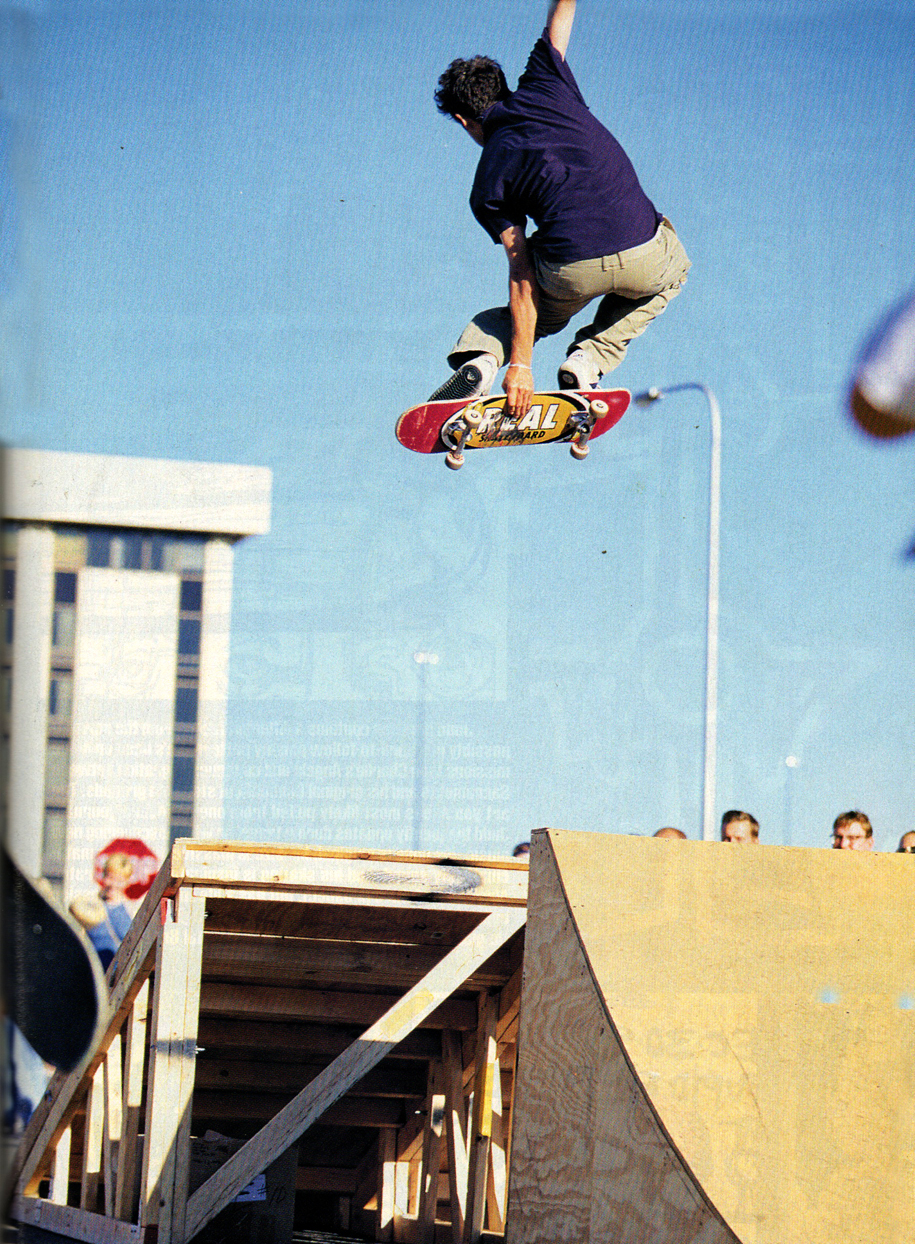
Gonz, front Stale 180 from a Hook-Ups tour article (Photo: Atiba). TWS March 1998, Vol.16, No.3.
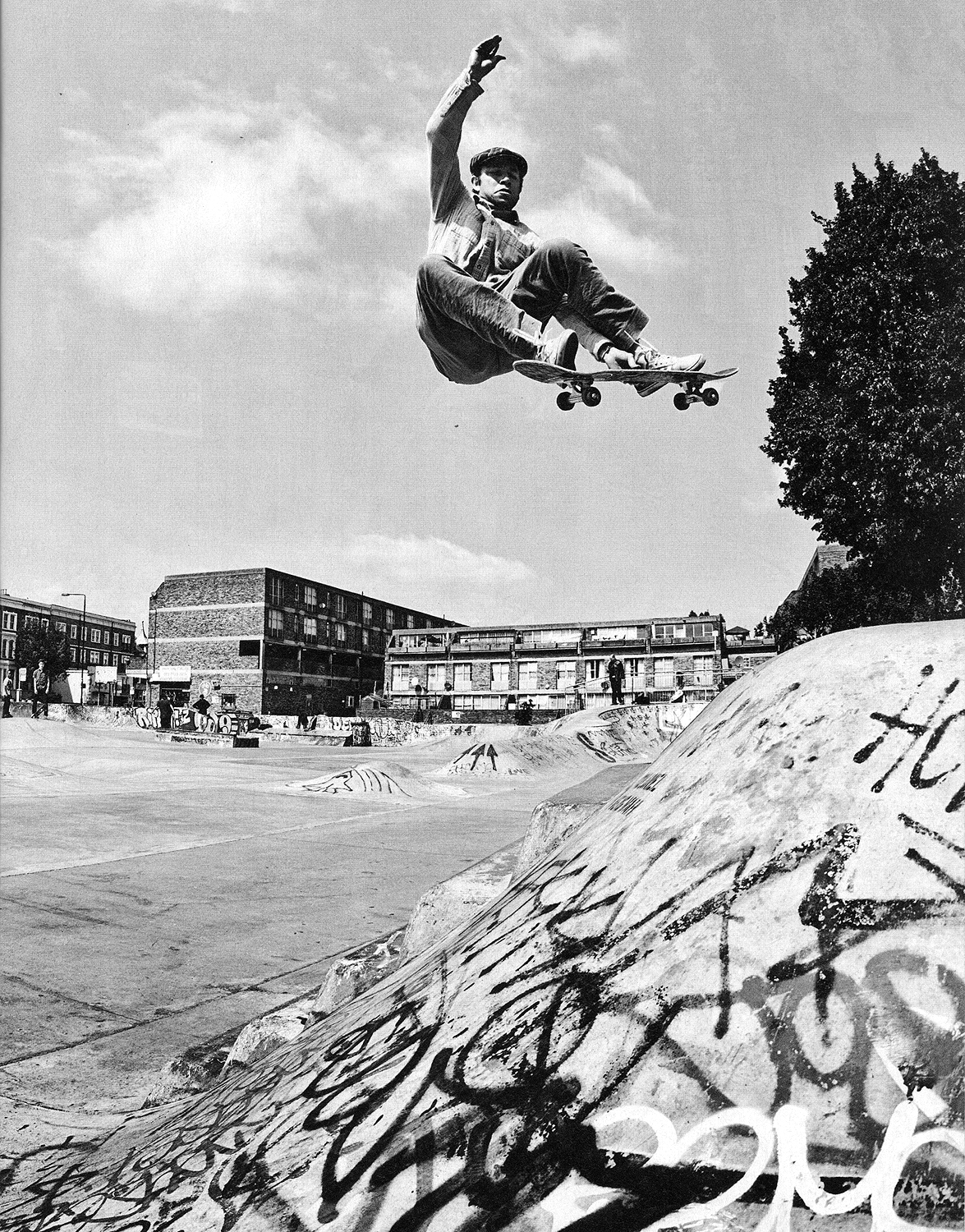 Mark grabs Stale in Stockwell, London for his Pro Spotlight in our 30 Most Influential issue, Jan. 2012, Vol.30, No.1. Photo: Skin Phillips.
Mark grabs Stale in Stockwell, London for his Pro Spotlight in our 30 Most Influential issue, Jan. 2012, Vol.30, No.1. Photo: Skin Phillips.
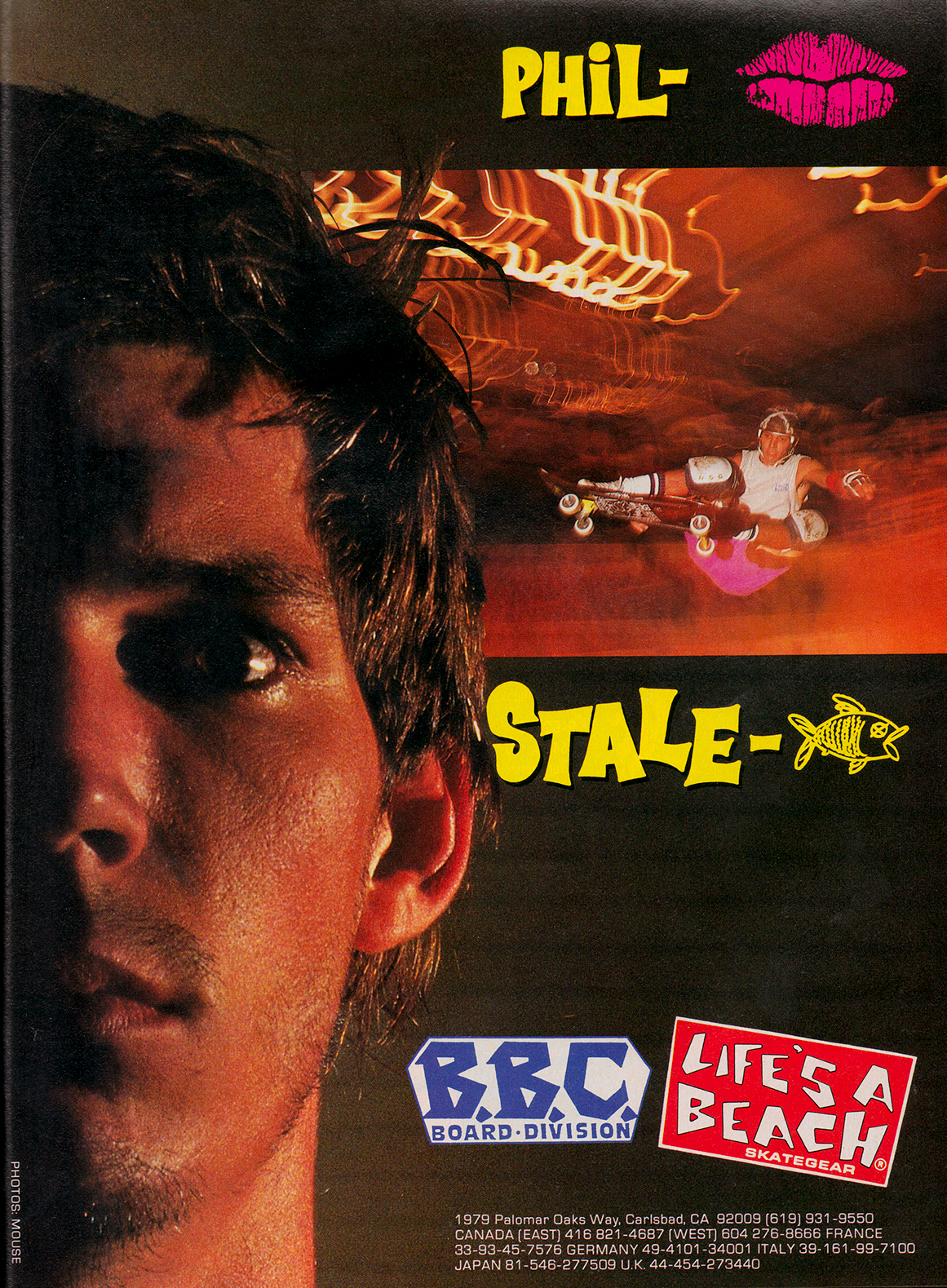
Since he was Mark's initial inspiration, Jeff Phillips also did eventually reach up and grab it Stalefish. BBC ad (Photo: Mouse), TWS Aug. 1989, Vol. 7, No. 4. RIP Jeff Phillips.
Follow @eurocana2016 on Instagram for a special reunion of the Swedish Skate Camp this August in Stockholm.
Follow @krooked on Instagram.
Follow @tonyhawk on Instagram.
Follow @lancemountain on Instagram.
Follow @jgrantbrittain on Instagram.
Follow @deadhippie on Instagram.
Since posting the Origins of the Stalefish article last Thursday— detailing the creation of the grab with Tony Hawk and Mark Gonzales—a number of people reached out and provided new information from that glorious summer in Sweden some 31 years ago where Tony first had the name coined for him.
Here is a quick recap of new facts for those interested in further solving the mystery:
FIRST FRONT STALE PHOTO, 1985
First up, photographer Dan Bourqui contacted me to inform me that he was all but sure he had shot a photo of Tony doing a frontside Stale over the channel at Eurocana 85. He didn't have a copy or the original negatives as he had sent it to a magazine in Brazil back in 85 called Yeah!. But after contacting some friends in Brazil and a few days of trial and error, Dan was successful in tracking down the article.
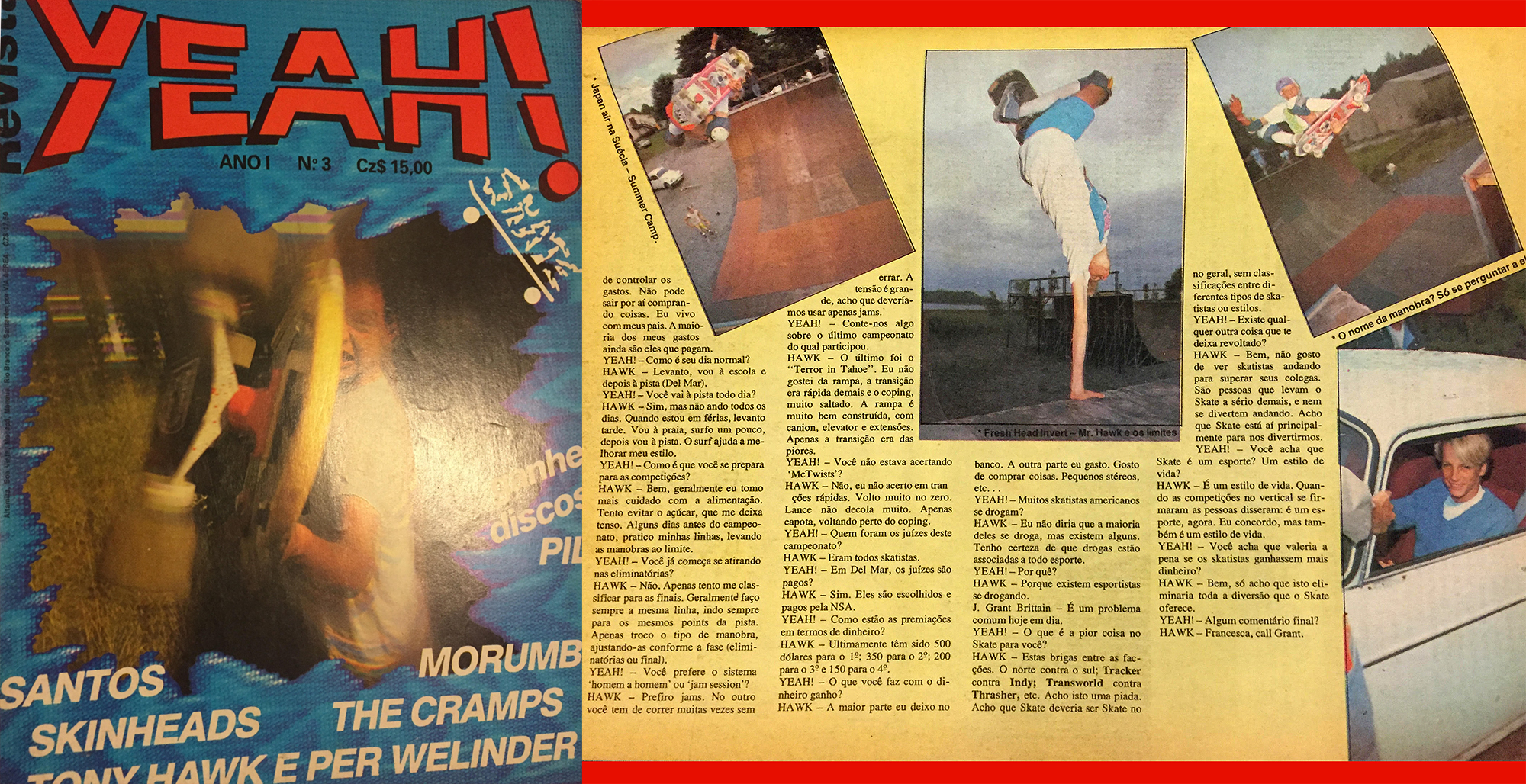 Yeah! Magazine, Brazil, 1985/86. Tony Hawk Interview. Stale is top right. Photo: Bourqui.
Yeah! Magazine, Brazil, 1985/86. Tony Hawk Interview. Stale is top right. Photo: Bourqui.

A blown up look: The first photo of a front stale ever. The Portuguese caption states: "The name of this trick? You'll have to ask him (Tony)." Tony is also riding the '85 Hawk board he was riding in Martin Willners' backside Stale photo so by all accounts this was at the same time or before the backside version. Photo: Bourqui. Sweden, 1985.
So thanks to this contribution from Dan Bourqui, we can say for sure that Tony also did frontside Stales in '85. And, in a nod to Gonz, Tony is most definitely "palming" it.
GEMMA NOT ANNA
Mark Gonzales and his wife Tia were nice enough to email me over the weekend and let me know that they both read and liked the article. That alone was huge for me. One small problem, their daughter is named Gemma, not Anna as I had stated in the original story! My apologies. I made the correction this past Sunday. Thanks guys!
GAY TWIST STALES, 1986
Next up, Larry Ransom and a couple of other people on the Slap boards dug up this sequence that I had missed from Neil Blender's Aggro Zone column "A Story of Men" TWS August 1986. Neil's text alone is incidentally amazing. But here was Tony at a contest in Houston in '86, already doing a fakie 360 version of the grab, still a full year before the session at Bourges with Gonz. Again, nobody knows what to call the trick; the caption reads, "God knows what over the channel." Outside of showing just how tech the Birdman was, this sequence fits with the conclusions from the original story. Clearly, Tony was not only doing Stalefish grabs before '87, he was doing variations too (frontside, backside, Gay Twist...).
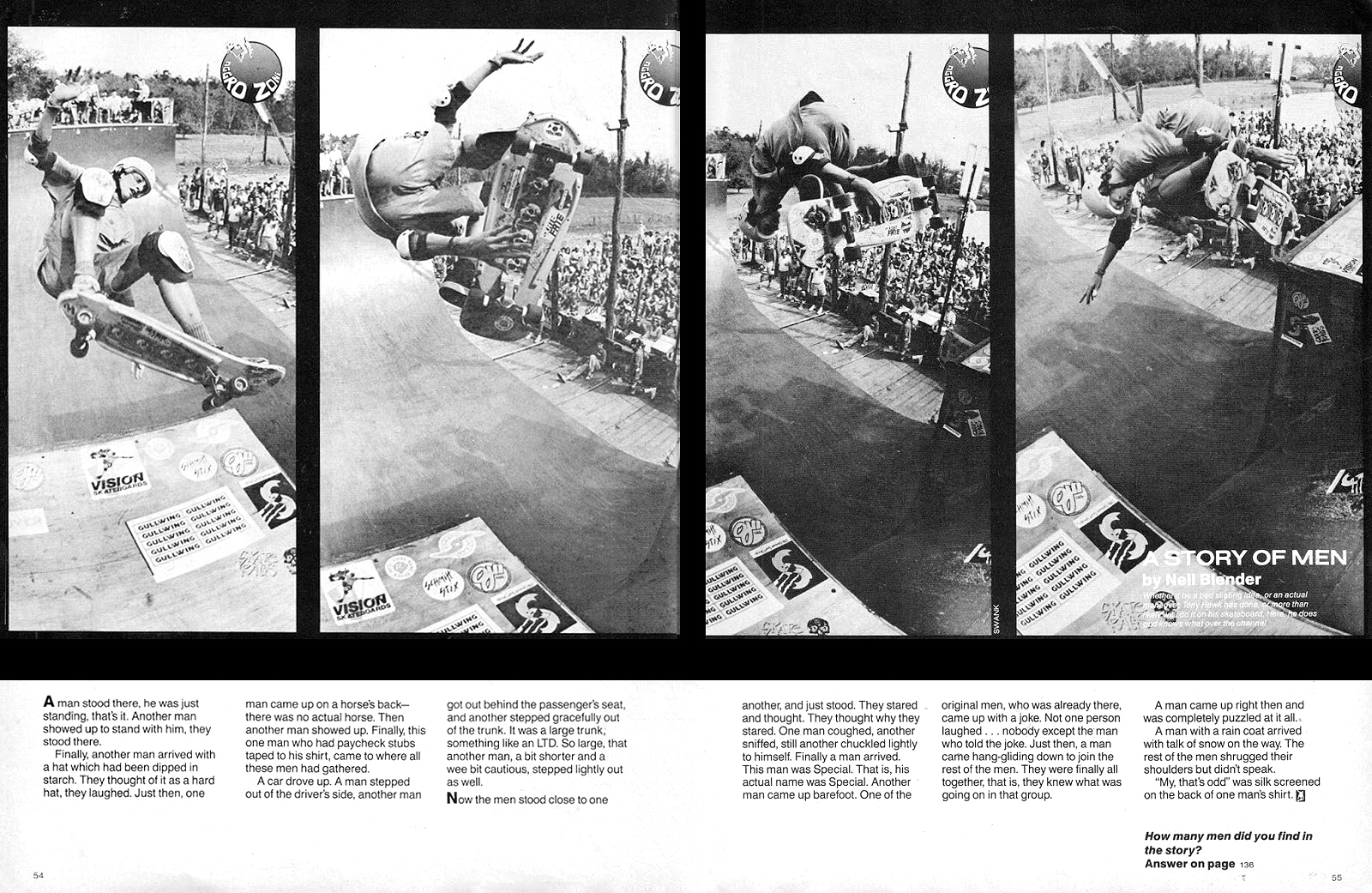 Aggro Zone was so rad. Tony Hawk, Gay Stale Twist, Houston, 1986. Photo: Swank. TWS, Aug. 1986, Vol. 4, No. 4.
Aggro Zone was so rad. Tony Hawk, Gay Stale Twist, Houston, 1986. Photo: Swank. TWS, Aug. 1986, Vol. 4, No. 4.
BARRY ABROOK, THE MAN WHO NAMED THE STALEFISH
Another mystery that was left unsolved was the actual identity of the "English camper" who had grabbed Tony's diary describing the camp food and inadvertently named the grab the Stalefish. Martin Willners had looked on his end with no luck. After first looking for a "Mark Edwards" as Tony thought that might be the name, Martin had asked a Mark Evans who was definitely at the camp but claimed it wasn't him. From there, Martin had suggested Mark and Barry Abrook. While Mark Abrook had gotten back to me on Facebook saying it wasn't him, last we spoke he was going to ask his brother. Once the article was published, Barry and Tony had this back-and-forth in the story's comments.

Barry Abrook and Tony Hawk reunited. Comments section, The Origins of the Stalefish (2016).
The case might not be absolutely airtight, but that's about as close to solving it as we might get. Thanks Barry for apparently giving skateboarding one of its cooler sounding tricks. Also, I'd like to endorse the terms "Smithy Wear" and "Mudskipper."
SLAPPO'S STALE-EGG-DRECHT, 1985
Finally, just to show that there will never be 100-percent certainty on anything, Puttis Jacobsson and the guys at @eurocana2016 sent me this photo that Martin Willners also shot at the camp that summer (85) of the legendary Mikael Slappo Adolfsson hoisting one of his signature "Eggdrechts"—basically a Stalefish Eggplant—during the same sessions that Martin and Dan Bourqui had shot Tony's first Stalefish airs. According to Lee Bryan on Martin's Eurocana Facebook page, Slappo may have been doing the trick as far back as 1983. So while Tony Hawk still most definitely now has the two first Stalefish air photos, other variations like this one all but certainly came before or at the same time.

Slappo's "Eggdrecht" or Stale-Egg. Eurocana, 1985. Photo: Martin Willners.
Huge thanks again to Martin, Dan, Larry, Barry and Mark Abrook, Tony, Gonz and Tia, Grant, Lance, and everyone else who helped make this story happen. And don't forget to check out @eurocana2016 and the camp reunion this August in Stockholm. Stay Stale. ME.

